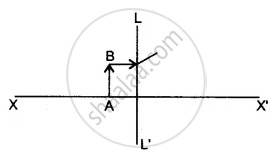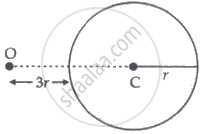Advertisements
Advertisements
प्रश्न
Kavita from 10th is using spectacles. The power of the lenses in her spectacles is –2.5 dioptre. Answer the following questions:
1) Which lenses are used in her spectacles?
2) State the defect of vision Kavita is suffering from.
3) Find the focal length of the lenses used in her spectacles
उत्तर
1) Concave lens
2) Myopia or nearsightedness
3) `f = 1/D = 1/2.5 = 0.4 m`
APPEARS IN
संबंधित प्रश्न
Calculate the focal length of a corrective lens having power +2.5 D.
What does sign of power (+ve or –ve) indicate?
A doctor has prescribed a corrective lens of power +1.5 D. Find the focal length of the lens. Is the prescribed lens diverging or converging?
Ranbir claims to have obtained an image twice the size of the object with a concave lens. Is he correct? Give a reason for your answer.
The lens mentioned in 6(b) above is of focal length 25cm. Calculate the power of the lens.
Which one of the following materials cannot be used to make a lens?
Which has more power : a thick convex lens or a thin convex lens, made of the same glass? Give reason for your choice.
The focal length of a lens is +150 mm. What kind of lens is it and what is its power?
An object of height 4.25 mm is placed at a distance of 10 cm from a convex lens of power +5D. Find (i) the focal length of the lens, and (ii) the size of the image.
Two lenses A and B have focal lengths of +20 cm and, −10 cm, respectively.
(a) What is the nature of lens A and lens B?
(b) What is the power of lens A and lens B?
(c) What is the power of combination if lenses A and B are held close together?
What do you understand by the power of a lens? Name one factor on which the power of a lens depends.
A diverging lens has a focal length of 0.10 m. The power of this lens will be:
State the condition for the following a ray passes undeviated through the lens .
The power of a lens is + 1.0 D is :
Express the power (with sign) of a concave lens of focal length 20 cm.
How does focal length of a lens change when red light incident on it is replaced by violet light? Give reason for your answer.
A double convex lens has two surfaces of equal radii R and refractive index \[m = 1 \cdot 5\]
A symmetric double convex lens in cut in two equal parts by a plane perpendicular to the principal axis. If the power of the original lens was 4 D, the power a cut-lens will be
A stick partly immersed in water appears to be bent. Draw a ray diagram to show the bending of the stick when placed in water and viewed obliquely from above.
Complete the diagram to show the formation of the image of the object AB.

(i) Name the Lens LL’.
(ii) Where is the image of the object AB formed?
(iii) State three characteristics of the image.
If the lens is of focal length 25 cm. Calculate the power of the lens.
The power of the magnifying glass depends on the distance of the magnifying glass from object.
Find the power of a convex lens of focal length of + 25 cm.
Power of a lens is – 4D, then its focal length is
The power of lens depends on the focal length of the lens
Match the following:
| Column - I | Column - II | ||
| 1 | Retina | a | Path way of light |
| 2 | Pupil | b | Far point comes closer |
| 3 | Ciliary muscles | c | near point moves away |
| 4 | Myopia | d | Screen of the eye |
| 5 | Hypermetropia | e | Power of accommodation |
What is power of accommodation of eye?

The above lens has a focal length of 10 cm. The object of height 2 mm is placed at a distance of 5 cm from the pole. Find the height of the image.
The focal length of a concave lens is 20 cm. The focal length of a convex lens is 25 cm. These two are placed in contact with each other. What is the power of the combination? Is it diverging, converging or undeviating in nature?
A convex lens with radii of curvature R1 = R2 is immersed in water. Assuming that the refractive indices of glass and water are 3/2 and 4/3 respectively, its focal length f1 in comparison to that in air, f, is ______.
A point object is placed at O in front of a glass sphere as shown in figure.

Show the formation of the image by the sphere.
When monochromatic red light is used instead of blue light in a convex lens, its focal length will ______.
The power of convex lens of focal length 20 cm is ______.
The focal length of a double convex lens is equal to the radius of curvature of either surface. What is the refractive index of its material?
